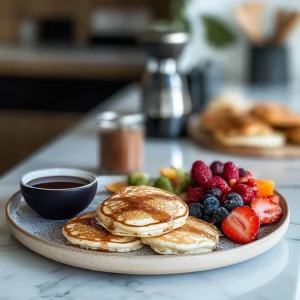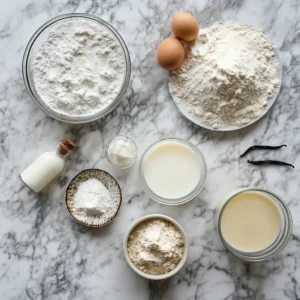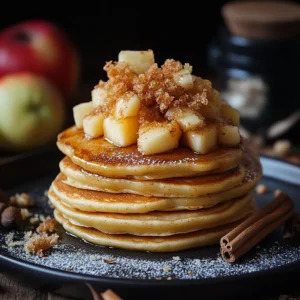Making pancakes at home allows you complete control over your ingredients and flavors, ensuring a fresher and more personalized breakfast.
This guide focuses on a small batch approach, ideal for preparing just enough pancakes for one or two people, minimizing waste and maximizing taste.
Introduction

There is something incredibly satisfying about preparing your own pancakes. Not only do you get to control the quality of the ingredients, but you also have the freedom to experiment with flavors and textures. A homemade pancake recipe small batch offers the perfect solution when you want to enjoy a freshly made breakfast without ending up with extra, wasted food.
This article will guide you through:
- The importance of using the right ingredients.
- Detailed instructions for creating a smooth, well-mixed batter.
- Cooking techniques to ensure even browning and a tender bite.
- Tips for enhancing flavor and texture.
- Ways to modify the recipe for gluten-free, vegan, or protein-boosted options.
By the end of this guide, you will be well-equipped to make delicious pancakes that suit your lifestyle and taste preferences.
Essential Ingredients

The success of your homemade pancake recipe small batch depends on choosing high-quality ingredients. Below is a breakdown of what you need and why each element is important:
Dry Ingredients
- 1 cup flour
Serves as the foundation of the pancake, providing structure and texture.
Tip: Use all-purpose flour for a balanced outcome. - 2 teaspoons baking powder
Acts as the leavening agent, ensuring that your pancakes are light and fluffy. - 1 tablespoon sugar
Adds a subtle sweetness that enhances the overall flavor. - A pinch of salt
Elevates all the flavors and balances the sweetness.
Wet Ingredients
- 1 egg
Helps to bind the ingredients together and adds richness to the batter. - ¾ cup milk
Provides moisture and can be substituted with plant-based alternatives like almond, soy, or oat milk. - 2 tablespoons melted butter or oil
Contributes to the moist and tender texture of the pancakes. - 1 teaspoon vanilla extract (optional)
Adds a delicate aroma and extra depth to the flavor profile.
Optional Toppings & Mix-ins
- Fruits:
Fresh berries, sliced bananas, or diced apples for a fruity twist. - Extras:
Chocolate chips, chopped nuts, or seeds for added texture and nutrition. - Classic Toppings:
A dusting of powdered sugar, a drizzle of maple syrup, or a spoonful of honey.
Key Points Recap:
- Flour provides structure.
- Baking powder ensures a fluffy rise.
- Sugar and salt balance the flavor.
- Egg and milk bind and add moisture.
- Butter/oil enriches the batter.
- Vanilla enhances aroma and taste.
Equipment and Preparations
Before you begin, make sure you have the necessary tools to make the process smooth and enjoyable:
- Mixing Bowl: A large bowl to combine all ingredients.
- Whisk or Fork: Essential for mixing the batter until it’s smooth and free of lumps.
- Sifter: Useful for sifting flour and baking powder to prevent clumping.
- Non-Stick Frying Pan or Griddle: Crucial for evenly cooking your pancakes.
- Spatula: For flipping the pancakes gently without breaking them.
Investing in quality kitchen tools can significantly improve your cooking experience. For more on kitchen tools, read our guide on How to Sharpen a Knife.
Step-by-Step Instructions
Follow these detailed, bullet-pointed steps to prepare your homemade pancake recipe small batch:
Step 1: Prepare the Dry Ingredients
- Mixing:
In a large bowl, sift together 1 cup of flour, 2 teaspoons of baking powder, 1 tablespoon of sugar, and a pinch of salt.
This ensures that there are no lumps and that the ingredients are evenly distributed.
Step 2: Prepare the Wet Ingredients
- Blending:
In a separate bowl, beat 1 egg thoroughly. Add ¾ cup of milk, 2 tablespoons of melted butter (or oil), and 1 teaspoon of vanilla extract (if using). Mix until the wet ingredients are completely combined.
Tip: Using room temperature ingredients helps the batter mix more effectively.
Step 3: Combine the Ingredients
- Creating the Batter:
Pour the wet ingredients into the bowl with the dry ingredients. Stir gently with a whisk or fork until just combined.
Important: Overmixing can lead to a dense texture. A few small lumps in the batter are acceptable and contribute to a tender pancake.
Step 4: Prepare the Pan
- Heating and Greasing:
Preheat your non-stick frying pan or griddle over medium heat. Lightly grease the surface with butter or oil to prevent the pancakes from sticking. Hint: Test the heat by flicking a few drops of water onto the pan—if they sizzle and evaporate quickly, the pan is ready.
Step 5: Cook the Pancakes
- Cooking Process:
Using a ladle or measuring cup, pour approximately 1/4 cup of batter for each pancake onto the preheated pan. Cook until bubbles appear on the surface and the edges begin to set, which usually takes about 2-3 minutes. Carefully flip the pancake with a spatula and cook the other side for an additional 1-2 minutes until it turns a golden brown. Adjust the heat if necessary to avoid burning.
Step 6: Serve Immediately
- Plating:
Transfer the pancakes to a plate, ideally one that is preheated to keep them warm. Add your favorite toppings—fresh fruit, maple syrup, a sprinkle of powdered sugar, or any mix-ins you prefer. Enjoy your pancakes while they are hot for the best texture and flavor.
Quick Recap in Bullet Points:
- Dry Mix: Sift flour, baking powder, sugar, and salt.
- Wet Mix: Beat egg and combine with milk, melted butter, and vanilla.
- Combine: Stir wet and dry ingredients gently.
- Preheat: Heat and grease the pan properly.
- Cook: Pour, wait for bubbles, flip, and cook until golden.
- Serve: Plate immediately with your chosen toppings.
For more creative kitchen ideas, check out our internal guide on Homemade Pancake Recipe Small Batch.
Chef’s Tips for Perfect Pancakes
Even a simple recipe benefits from a few professional tips:
- Temperature Control:
Maintaining a medium heat is crucial. Too high, and the pancakes may burn; too low, and they might turn out dense. - Resting the Batter:
Let your batter rest for 5 to 10 minutes before cooking. This allows the ingredients to meld and results in a lighter texture. - Gentle Mixing:
Stir only until the ingredients are combined. Overmixing can activate the gluten in the flour, leading to tougher pancakes. - Experiment with Mix-Ins:
Enhance your pancakes by adding blueberries, banana slices, or even a pinch of cinnamon directly into the batter. - Consistent Portions:
Use a ladle or measuring cup for even-sized pancakes, ensuring uniform cooking. - Internal Inspiration:
For further culinary creativity, read our article on How to Combine Spices.
Variations and Personalizations

One of the great advantages of this homemade pancake recipe small batch is its versatility. Here are some variations to suit different dietary preferences and flavor profiles:
Gluten-Free Pancakes
- Substitution:
Replace traditional flour with a gluten-free blend.
Note: Gluten-free flours may require slight adjustments in the amount of liquid.
Vegan Pancakes
- Egg Replacement:
Use a “flax egg” (1 tablespoon ground flaxseed mixed with 3 tablespoons water) as a substitute for the egg. - Milk Alternative:
Substitute dairy milk with almond, soy, or oat milk. - Oil Instead of Butter:
Use vegetable oil to maintain the desired texture.
Protein-Packed Pancakes
- Boosting Nutrition:
Incorporate a scoop of protein powder into your dry ingredients. Add extra nutritional value with chia seeds or a handful of oats.
Seasonal Flavor Variations
- Summer:
Mix in fresh blueberries or raspberries for a burst of flavor. - Autumn:
Add grated apples and a dash of cinnamon or nutmeg for a warm, comforting taste. - Winter:
Incorporate citrus zest, such as lemon or orange, for a refreshing twist.
These modifications allow you to adapt your pancakes to your taste and nutritional needs. For more inspiration, explore our recipe on The Best Chocolate Chip Pancake Recipes.
Nutritional Benefits
Preparing pancakes at home offers several advantages beyond taste:
- Ingredient Control:
You choose high-quality, fresh ingredients without preservatives or additives. - Portion Precision:
A small batch recipe helps you manage portion sizes, reducing calorie intake and minimizing waste. - Customizable Nutrition:
Enhance the nutritional value by adding fruits, nuts, or seeds directly into the batter. - Balanced Breakfast:
Serve your pancakes with a side of yogurt, a glass of fresh juice, or a smoothie to create a well-rounded meal.
Perfect Pairings
Enhance your pancake experience by pairing them with complementary dishes and beverages:
Beverage Options
- Fresh Orange Juice:
A classic, vitamin C-rich choice. - Coffee or Tea:
A warm cup of coffee or a soothing herbal tea can balance the sweetness of your pancakes. - Smoothies:
Blend your favorite fruits for a nutritious, refreshing drink.
Side Dishes
- Yogurt:
Serve with plain or Greek yogurt for a creamy contrast. - Fruit Salad:
A colorful mix of seasonal fruits adds a fresh and healthy element. - Granola:
Sprinkle a bit of homemade granola for extra crunch and texture.
For more ideas on complementary recipes, you might enjoy our guide on Brazilian Lemonade: Refreshing Lime Drink Recipe.

Small Batch Homemade Pancakes
Equipment
- Mixing Bowl
- Whisk or Fork
- Sifter
- Non-Stick Frying Pan or Griddle
- Spatula
- Measuring cups and spoons
Ingredients
- 1 cup all-purpose flour sifted
- 2 teaspoons baking powder
- 1 tablespoon sugar
- 1 pinch salt
- 1 egg room temperature
- 3/4 cup milk or plant-based alternative
- 2 tablespoons melted butter or oil
- 1 teaspoon vanilla extract optional
- toppings maple syrup, fresh fruit, powdered sugar, etc.
Instructions
- In a large mixing bowl, sift together the flour, baking powder, sugar, and salt to ensure even distribution.
- In a separate bowl, beat the egg. Add the milk, melted butter (or oil), and vanilla extract, and mix until well combined.
- Pour the wet ingredients into the dry ingredients. Stir gently until just combined. Do not overmix; small lumps in the batter are fine.
- Preheat a non-stick frying pan or griddle over medium heat. Lightly grease with butter or oil.
- Using a ladle or measuring cup, pour about 1/4 cup of batter per pancake onto the pan.
- Cook until bubbles form on the surface and the edges begin to set, about 2-3 minutes. Flip and cook for another 1-2 minutes until golden brown.
- Transfer to a plate and keep warm while cooking the remaining pancakes.
- Serve hot with your favorite toppings such as maple syrup, fresh fruit, or a dusting of powdered sugar.
Notes
Frequently Asked Questions (FAQs)
What Makes a Small Batch Pancake Recipe Different?
A small batch recipe is designed to produce just enough pancakes for one or two people. This approach ensures that the pancakes remain fresh and reduces food waste.
Can I Adapt This Recipe for Gluten-Free or Vegan Diets?
Absolutely. Simply substitute the regular flour with a gluten-free alternative and use plant-based milk. For a vegan version, replace the egg with a flax egg.
How Can I Store Leftover Batter?
It is best to use the batter immediately for the best texture. However, you can store any unused batter in the refrigerator for up to 24 hours. Stir it gently before cooking, as the consistency may change slightly.
What Toppings Do You Recommend?
The toppings are highly versatile. Classic options include maple syrup, honey, and powdered sugar. You can also experiment with fresh fruit, chocolate chips, or even a dollop of Greek yogurt.
How Do I Scale the Recipe for More Servings?
Simply multiply the ingredient quantities by the number of servings needed. The technique remains the same, ensuring that every pancake is cooked to perfection.
Conclusion
In summary, this homemade pancake recipe small batch is an ideal solution for those who want a fresh, delicious breakfast without the hassle of leftovers. By following this detailed guide, you will be able to:
- Select high-quality ingredients that ensure a fluffy and light texture.
- Master the step-by-step process to create a perfectly balanced pancake batter.
- Experiment with various toppings and mix-ins to suit your taste and nutritional needs.
- Adapt the recipe for gluten-free, vegan, or protein-enriched versions as desired.
- Enjoy a balanced, energy-boosting breakfast that supports a healthy lifestyle.
Whether you’re a beginner or a seasoned home cook, making pancakes in a small batch allows you to focus on quality and customization. With internal resources like our guides on How to Combine Spices and How to Sharpen a Knife, you have all the tools needed to elevate your culinary skills.
So, dust off your mixing bowl, heat up your non-stick pan, and enjoy the process of creating a breakfast that’s not only delicious but also tailored to your needs. Happy cooking, and may your mornings be filled with the delightful aroma of freshly made pancakes!
For further inspiration on breakfast innovations, check out this excellent external resource from Bon Appétit.
Bon Appétit and enjoy every moment spent in the kitchen as you create your very own small batch of mouthwatering pancakes!

